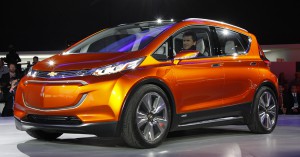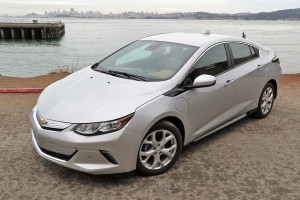Often criticized for the way it hammers price cuts out of its suppliers, General Motors is taking a very different approach in the development of its first long-range battery-electric vehicle, the Chevrolet Bolt. In a joint news conference with Korea’s LG Corp., GM officials outlined a new strategy putting a premium on partnership.
The new approach could be a blueprint for the future, suggested Mark Reuss, GM’s global product development director. It may also help LG become a major force in the emerging electric vehicle market, rather than just being relegated to supplying batteries to carmakers like GM.
“GM used to act more like a dictator than a customer,” said Reuss, during a tour of the electric vehicle operations at the maker’s suburban Detroit technical center. That approach, primarily focused on squeezing out costs, is “unsuitable and unsustainable,” Reuss added.
That became all the more apparent, he and other officials noted, as GM set out to put development of the Bolt on the fast-track. Unveiled in concept form at the January 2015 Detroit Auto Show and approved for production a few months later, the goal is to have the battery-car in showrooms next year – lightning speed in automotive terms.
(Click Here for a review of the gen-2, 2016 Chevrolet Volt plug-in.)
GM and LG have a relationship dating back almost a decade. The Korean firm won a shoot-out among battery suppliers for the Chevy Volt contract. Not to be confused with Bolt, that model became the industry’s first mass-market plug-in hybrid when it went on sale late in 2009. LG Chem, the Korean company’s battery arm, also won the contract for the Chevy Spark, a pure battery-electric vehicle, or BEV.
It was the go-to supplier when work began on the Chevrolet Bolt. But GM realized that while price matters, it needed to do more than just save a few dollars on the EV’s batteries. It also had to address two other critical challenges: range and utility.
“We solved those” by working collaboratively, claimed Reuss, LG taking the lead on much of the Bolt’s powertrain.
“This car will become desirable because people will want (it), not because it is an EV,” said Reuss.
(Vacuum maker Dyson buys promising Mich battery start-up – but GM also owns a stake. Click Here for more.)
The various LG units, including its powerful LG Electronics arm, will have a dozen different major components on the Bolt. That includes the batteries and several key parts of the powertrain, including its onboard charger. But LG Electronics also will provide display and infotainment systems for the new car.
For LG, as a whole, the Chevy Bolt project could be a harbinger of a new, higher-profile role in the battery-car market. “Our vision is to become an electric powertrain supplier to the auto industry” beyond just GM, said Ken Chang, Vice President – LG Electronics, Vehicle Components Division.
The company is investing $250 million in an engineering and manufacturing facility in Incheon, just outside Seoul, to develop and manufacture Bolt components. But that new facility could readily serve other GM projects – and other manufacturers.
As for GM, “We feel good about what the relationship with LG has taught us about our relations with other suppliers,” said Reuss.
Those other suppliers are likely going to want proof. GM has traditionally scored low in studies of the working relationship between automakers and parts manufacturers.
Consumers will also be waiting to see the results.
For their part, neither Reuss nor Bolt chief engineer Pam Fletcher would predict the volumes they expect once the battery-car goes on sale. GM officials don’t want to repeat the mistakes made when they offered overly optimistic forecasts for the Chevy Volt – especially at a time when low fuel prices have hurt sales of alternative-power vehicles.
But GM is hoping to “crack the code” with the new car, said Reuss, by offering at least 200 miles per range and a price tag of around $35,000 – which will drop below $30,000 once federal and state incentives get factored in.
(Click Here to check out the five finalists for Green Car of the Year.)



I’d bet there are hundreds of GM suppliers that will believe that GM has changed when they see it in their contracts and no sooner. Ford isn’t much better when they make vendors wait 300 days to get paid or they lose the contract. Then there are the yearly decreases in price that vendors must charge for each year of a contract. It’s no wonder that product quality has taken a big hit along with customer satisfaction.